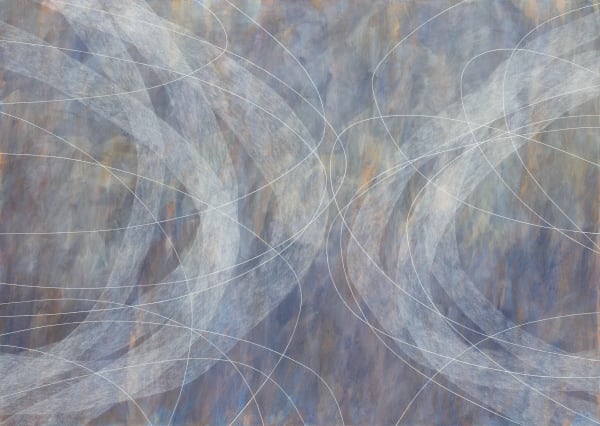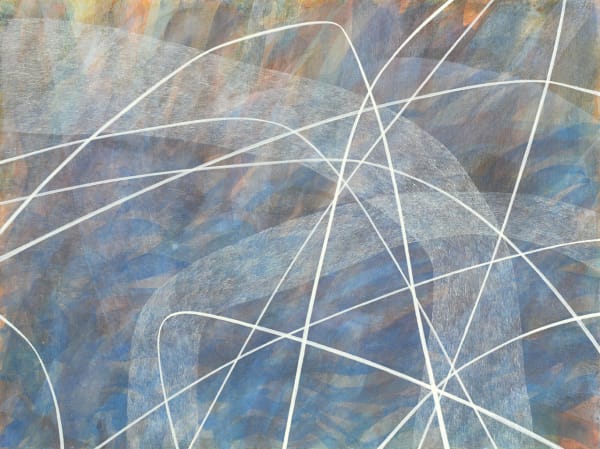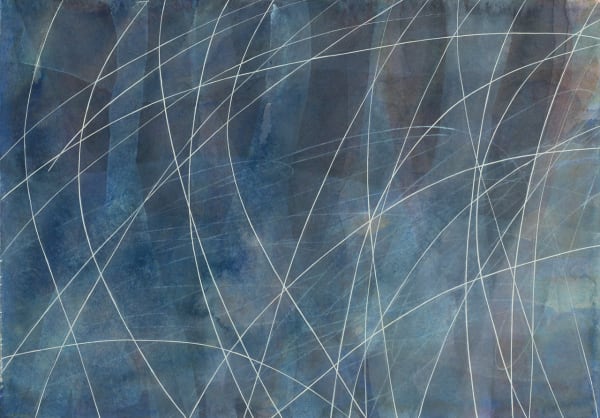Windwalking
The term 'wind-walking' originates from Mawson's Antarctic expedition, which landed in January 1912 at Cape Denison in Commonwealth Bay in Adelie Land. Adelie Land is said to be one of the windiest places in the world. One of the expeditioners, Charles F. Laseron, describes how the men developed the skill of 'wind-walking' as,
leaning at an angle and bracing our feet against every projecting piece of rock and ice. In this way we could walk against a 70 miler, and could stand against an 80, but when the 90 and 100 miles were reached we gave up, and were content to wriggle about like snakes 1.
What I love about this quote is the way it reflects the spirit with which these fellows engaged with their environment and the challenges of working under extreme winds. It communicates something of the thrill that the wind and wild weather can invoke. I also feel that there is actually something quite un-heroic about the expression, something closer to pure joy, which is at odds with the commonly held perception of Antarctic explorers as Romantic and Heroic.
My use of the term wind-walking for my exhibition is not a reference to Antarctica (although I have been there too) but to some of my recent experiences on Tasman Island - a very windy, cliff walled, uninhabited, isolated, little island off the SE coast of Tasmania. A place that is actually quite tricky to get too.
Over the years I have been visiting Tasman Island as a volunteer weeder on Wildcare working bees. So I have got to know the place slowly through crawling about amongst the grasses spraying Californian Thistles. At the end of last year, a friend and I conspired to spend a bit longer there on a painting trip. We chose November because we knew it would be seriously windy, and it was. The island shook itself madly like a wet animal for what seemed like weeks then stopped for ten minutes then shook itself for more weeks only from the other direction. My poor little tent barely coped and at night the sound resembled something like being camped at Tullamarine airport. But I loved it - as only wind-walkers do. I loved looking over my shoulder to be suddenly startled by a monster dark cloud about to drench me, and sliding in under the low canopy of the elephant trunked banksias to get some protection and watch the squall pass. Then another would be looming up from Cape Raul to the South, 5 minutes till it hit. I often tucked myself into the long grasses, the Poas and watched the world from within the grass - flapping about madly over my head and the ocean beyond whipping itself into a frothing foaming frenzied mass of white.
At night in my tent, I lay there wide awake while the wind flattened the tent around me every few seconds and listened to the sounds. I thought how each gust was like a knot followed by the tiniest second of stillness only barely perceptible as it receded before another knot hit. And when the wind did eventually stop then the muttonbirds all started to arrive sounding like a flock of choking kookaburras.
What was interesting in my inquiry into the aesthetics of wind and weather was to consider how we experience it is largely through how it imprints onto the landscape or on our bodies - it seems so obvious that wind is an invisible thing, but what spatial form does it take? how do you give shape and form or visual expression to it? How do you notate the wind and weather - how do you write it?
There are other aspects of the trip that were a joy too: The sounds of whales going "pssh, pssh" every so often on a quiet day and seeing the dark mass of their bodies gently rolling through the water. Watching the albatrosses arcing their way through the swells, weaving an invisible thread. Watching the seals cooperatively fishing in the gulches below along the cliffs and the white spots of gulls and gannets circling and fishing above the inky blue water below. Or the time when a space ship cloud came in from the north over the cape and swallowed up the island into whiteness.
Sue Lovegrove 2012
Acknowledgments
Special thanks to Parks and Wildlife Service for letting us have such an adventure, in particular Stuart Dudgeon Senior Ranger Tasman Peninsular, Friends of Tasman Island, (Wildcare), Helicopter Resources (Simon and David), the tourist boat that fished us out of the water at the end, fellow artist Veronica Steane and Dr Pete Hay.
1. quoted in Ennis, Helen, A Man with a Camera, Frank Hurley Overseas, p12
-
 Sue LovegroveWindwalking 515, 2012acrylic and gouache on linen130 x 180cmAU$ 15,000.00
Sue LovegroveWindwalking 515, 2012acrylic and gouache on linen130 x 180cmAU$ 15,000.00 -
 Sue LovegroveWindwalking 516, 2012acrylic and gouache on linen130 x 180cmSold
Sue LovegroveWindwalking 516, 2012acrylic and gouache on linen130 x 180cmSold -
 Sue LovegroveWindwalking 517, 2012acrylic and gouache on linen130 x 180cmSold
Sue LovegroveWindwalking 517, 2012acrylic and gouache on linen130 x 180cmSold -
 Sue LovegroveWindwalking 505, 2012acrylic and gouache on linen90 x 130cmSold
Sue LovegroveWindwalking 505, 2012acrylic and gouache on linen90 x 130cmSold -
 Sue LovegroveWindwalking 506, 2012acrylic and gouache on linen90 x 130cmSold
Sue LovegroveWindwalking 506, 2012acrylic and gouache on linen90 x 130cmSold -
 Sue LovegroveWindwalking 507, 2012acrylic and gouache on linen90 x 130cmSold
Sue LovegroveWindwalking 507, 2012acrylic and gouache on linen90 x 130cmSold -
 Sue LovegroveWindwalking 509, 2012acrylic and gouache on linen90 x 130cmAU$ 6,600.00
Sue LovegroveWindwalking 509, 2012acrylic and gouache on linen90 x 130cmAU$ 6,600.00 -
 Sue LovegroveWindwalking 502, 2012acrylic and gouache on linen60 x 90cm
Sue LovegroveWindwalking 502, 2012acrylic and gouache on linen60 x 90cm -
 Sue LovegroveWindwalking 510, 2012acrylic and gouache on linen60 x 90cmSold
Sue LovegroveWindwalking 510, 2012acrylic and gouache on linen60 x 90cmSold -
 Sue LovegroveWindwalking 511, 2012acrylic and gouache on linen45 x 60cm
Sue LovegroveWindwalking 511, 2012acrylic and gouache on linen45 x 60cm -
 Sue LovegroveWindwalking 512, 2012acrylic and gouache on linen45 x 60cmSold
Sue LovegroveWindwalking 512, 2012acrylic and gouache on linen45 x 60cmSold -
 Sue LovegroveWindwalking 513, 2012acrylic and gouache on linen45 x 60cm
Sue LovegroveWindwalking 513, 2012acrylic and gouache on linen45 x 60cm -
 Sue LovegroveWindwalking 514, 2012acrylic and gouache on linen45 x 60cm
Sue LovegroveWindwalking 514, 2012acrylic and gouache on linen45 x 60cm -
 Sue LovegroveWindwalking 1, 2012watercolour and gouache on paper20 x 28.5cmSold
Sue LovegroveWindwalking 1, 2012watercolour and gouache on paper20 x 28.5cmSold -
 Sue LovegroveWindwalking 2, 2012watercolour and gouache on paper20 x 28.5cm
Sue LovegroveWindwalking 2, 2012watercolour and gouache on paper20 x 28.5cm -
 Sue LovegroveWindwalking 3, 2012watercolour and gouache on paper20 x 28.5cm
Sue LovegroveWindwalking 3, 2012watercolour and gouache on paper20 x 28.5cm -
 Sue LovegroveWindwalking 4, 2012watercolour and gouache on paper20 x 28.5cm
Sue LovegroveWindwalking 4, 2012watercolour and gouache on paper20 x 28.5cm -
 Sue LovegroveWindwalking 5, 2012watercolour and gouache on paper20 x 28.5cm
Sue LovegroveWindwalking 5, 2012watercolour and gouache on paper20 x 28.5cm -
 Sue LovegroveWindwalking 6, 2012watercolour and gouache on paper20 x 28.5cmSold
Sue LovegroveWindwalking 6, 2012watercolour and gouache on paper20 x 28.5cmSold -
 Sue LovegroveWindwalking 7, 2012watercolour and gouache on paper20 x 28.5cm
Sue LovegroveWindwalking 7, 2012watercolour and gouache on paper20 x 28.5cm





















